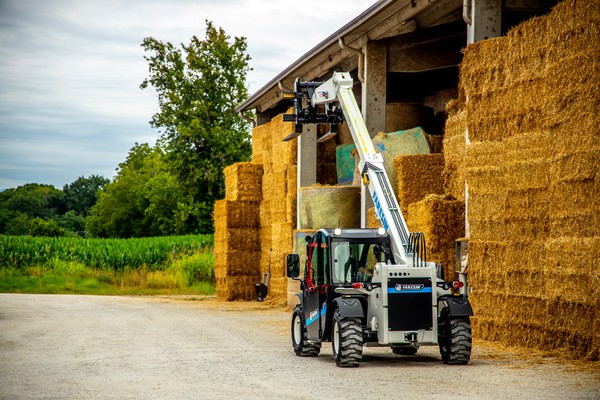
Rationalizing agricultural inputs to improve sustainability
The use of machinery and agricultural inputs inevitably impacts the environment. A study in the red meat production chain shows that, with limited cultivation and machinery-use-related adjustments, tangible benefits can be achieved
The environmental impact of a given production chain can be mitigated at various points and stages that may, however, be controlled by different actors. Hence, there is a need for careful coordination among the actors involved. In the case of red meat production, an increase in the sustainability of the end product can result from: optimizing field processing involved in forage production, reducing barn energy consumption, rational management of wastewater (e.g., by introducing anaerobic digestion establishments), as well as slaughtering and distribution operations.
A study called "Environmental effect of improved forage fertilization practices in the beef production chain," recently published in the Journal Science of the Total Environment, concerning life cycle assessment (LCA) for evaluating the environmental impact of beef cattle breeding, focused on the production of cereal silage on two farms located in the Po Valley, considering how optimization of cultivation techniques reduced environmental impact.
Life cycle assessment. According to ISO 14040 and 14044, the Life Cycle Assessment is structured into 4 different phases. Impacts were calculated per ton of product, thus both fodder grain and whole corn mash. In general, the nutritional value of the two components is more directly related to the dry matter content than to the fresh mass; however, since information regarding the moisture content of the two foods is not available at present, the different types of impact (environmental, energy, etc.) were necessarily related to the fresh matter. The study took into account all operations carried out to produce the inputs used (seeds, fertilizer, agricultural machinery, etc.) up to the cultivation and harvesting of fodder.
Fodder wheat cultivation was practiced on about 80 ha, with an average yield of 49.2 t/ha of product as is in 2019 and about 40 ha (average yield of 47.1 t/ha) in 2021; the difference noted relates substantially to fertilization, which in 2021 saw the use of digestate also in cover crops, replacing mineral fertilizers.
Conversely, whole-corn mash production was spread over about 170 ha, with an average yield of 14.5 t/ha for 2019 and about 255 ha (17.8 t/ha average yield) for 2021. In this case, the same cultivation technique was applied in the two years under consideration, although soil and climatic conditions and the adaptation of the farm's machinery fleet allowed some tillage to be carried out more promptly, recording, among other things, a short lengthening of the crop cycle. Regarding mechanization for both crops, two key aspects of the cultivation technique can be highlighted. The first is the distribution of digestate in pre-sowing, which is done using special manure spreaders equipped with injectors capable of distributing the organic fertilizer in furrows a few centimeters deep. This operation can be performed with one of the many technological solutions that are offered by both domestic (such as Vaia and Bonsegna) and international manufacturers. The deposition of organic fertilizer in furrows, compared with a slight increase in fuel consumption, makes it possible to reduce ammonia emissions related to volatilization. The consumption increase, which can be quantified in the order of a few kilograms per hectare, is related to the increased traction force required to open the furrows. The second element that characterizes the cultivation technique concerns primary tillage, which involves the use of minimum tillage seeders preceded by light primary tillage. Both of these choices have been adopted over the years on the basis of an optimization path that has included the analysis of the solutions available on the market as well as the monitoring of the production results and the characteristics of the soils destined for self-fodder production. The availability of the farm's fleet of medium-to-high horsepower tractors, enough to meet the demands of the manure spreader with injectors and minimum tillage machines, is one aspect that has had a positive impact.
The relative comparison between the two vintages shows how the different cultivation techniques of fodder wheat lead to non-negligible variations in environmental results. The non-use of urea in 2021 makes it possible to reduce the environmental costs associated with its production while also eliminating CO2 emissions related to its degradation in the field. This has a positive influence on the carbon footprint (-11%) and other impacts conditioned by energy, mineral and fossil resource consumption. Moreover, the significant increase in organic fertilizer (digestate) results in increased emissions of nitrogen compounds (e.g., ammonia) that cause increased acidification and particulate matter formation. In the case of corn mash in 2021, the marked increase in yield against the same production technique has led to a considerable reduction in environmental impact, as input consumption is amortized over increased production. The carbon footprint drops by 19 percent while the decrease in marine eutrophication is greater (-27%) because it benefits not only from increased production but also from reduced nitrate leaching achieved through improved nitrogen use efficiency (i.e., higher yields with the same amount of fertilization). Considering the entire production process, thus including the stable and manure management phase, the greater sustainability of the production of the two silage grains allows for a reduction in the impact of red meat, ranging from 0.4 to 4.8 percent, depending on the environmental effect. Moreover, this reduction does not consider any additional efficiency and mitigation actions implemented in the barn and manure management phase. While viewing the complete zeroing of impacts as being utopian (except for the carbon footprint, and only through the "accounting artifice" of purchasing carbon credits), to truly produce more sustainable goods requires the intervention of all actors in a supply chain. The case analysis shows that, even in the absence of large investments, but solely through optimization of fieldwork and substitution of mineral fertilizers with digested (among other things, available on the farm), it is possible to reduce them by about 5 percent.








